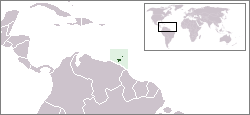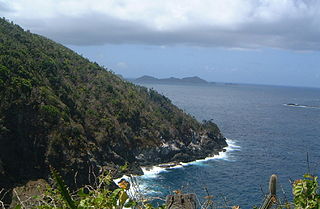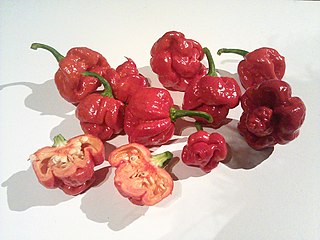
Tobago is an island and ward within the Republic of Trinidad and Tobago. It is located 35 kilometres (22 mi) northeast of the larger island of Trinidad and about 160 kilometres (99 mi) off the northeastern coast of Venezuela. It lies to the southeast of Grenada.

Trinidad is the larger and more populous of the two major islands of Trinidad and Tobago. The island lies 11 km (6.8 mi) off the northeastern coast of Venezuela and sits on the continental shelf of South America. It is often referred to as the southernmost island in the West Indies. With an area of 4,768 km2 (1,841 sq mi), it is also the fifth largest in the West Indies.
The Trinidad and Tobago national football team, nicknamed the "Soca Warriors", represents the twin-island Republic of Trinidad and Tobago in international football. It is controlled by the Trinidad and Tobago Football Association, which is a member of CONCACAF, the Caribbean Football Union (CFU), and the global jurisdiction of FIFA.

Trinidad and Tobago are continental islands with a geologically very recent history of direct land bridge connection to South America. As a result, unlike most of the Caribbean Islands, Trinidad and Tobago supports a primarily South American flora and fauna and has greater diversity of plant and animal species than the Antilles. However, rates of endemism are lower than in the rest of the Caribbean because there has been less time for genetic isolation from mainland populations because of the history of land bridge connections and hence fewer opportunities for speciation, and so a greater proportion of the species in Trinidad and Tobago are also found on the South American mainland. Trinidad is nearer to mainland South America and has been directly connected to the mainland via land bridges more often and for longer periods than Tobago. This, as well as Trinidad's larger size and more varied topography and hydrology compared to that of Tobago allow greater species and ecosystem diversity on the former compared to that on the later of the islands.

Little Tobago is a small island off the northeastern coast of Tobago, and part of the Republic of Trinidad and Tobago.

Trinidad and Tobago, officially the Republic of Trinidad and Tobago, is the southernmost island country in the Caribbean. Consisting of the main islands Trinidad and Tobago and numerous much smaller islands, it is situated 11 kilometres off the coast of northeastern Venezuela and 130 kilometres south of Grenada. It shares maritime boundaries with Barbados to the east, Grenada to the northwest and Venezuela to the south and west. Trinidad and Tobago is generally considered to be part of the West Indies. The island country's capital is Port of Spain, while its largest and most populous municipality is Chaguanas.

The coat of arms of Trinidad and Tobago was designed by a committee formed in 1962 to select the symbols that would be representative of the people of Trinidad and Tobago. The committee included artist Carlisle Chang (1921–2001) and carnival designer George Bailey (1935–1970).

Julius James is a Trinidadian footballer.

Gasparillo is a small island in the Republic of Trinidad and Tobago. It is one of the Bocas Islands, which lie in the Bocas del Dragón between the main island of Trinidad and Venezuela. The island is currently uninhabited.
Justicia flaviflora is a species of herbaceous plant in the family Acanthaceae. It was previously classified as Beloperone flaviflora. The species is endemic to the island of Trinidad in the Caribbean republic of Trinidad and Tobago where it is only known from near the peaks of mountains in the Northern Range. It is an erect herb with leaves up to 27 cm (11 in) long. It is suffering from habitat degradation and has become increasingly rare, being now rated as "critically endangered".

The Trinidad Scorpion Butch T is a Capsicum chinense cultivar that is among the hottest peppers in the world. It is a hybrid pepper and thus not indigenous to anywhere; however, its hybrid parentage is derived from the Trinidad Moruga scorpion indigenous to Trinidad and Tobago. It was named by Neil Smith from The Hippy Seed Company, after he got the seeds originally from Butch Taylor who is responsible for propagating the pepper's seeds. The "scorpion" peppers are referred to as such because the pointed end of the pepper is said to resemble a scorpion's stinger.

The Trinidad Moruga scorpion is a chili pepper native to the village of Moruga, Trinidad and Tobago. In 2012, New Mexico State University's Chile Pepper Institute identified the Trinidad Moruga scorpion as the hottest chili pepper at that time, with heat of 1.2 million Scoville heat units (SHUs).

Tityus exstinctus is an extinct species of scorpion belonging to the family Buthidae. It is only known from a single male collected in 1884 in the northern range of Martinique. The species epithet based on the fact that this taxon was already extinct when it was described.
Trevin Shonari Caesar is a Trinidad and Tobago footballer who plays as a forward for Club Sando. He made 15 appearances for the Trinidad and Tobago national team scoring three goals.
The 2019–20 West Indies Championship was the 54th edition of the Regional Four Day Competition, the domestic first-class cricket competition for the countries of the Cricket West Indies (CWI). The previous edition of the tournament was known as the Regional Four Day Competition before being rebranded by CWI. The competition started on 9 January 2020 and was scheduled to conclude on 5 April 2020. Six teams contested the tournament – Barbados, Guyana, Jamaica, the Leeward Islands, Trinidad and Tobago, and the Windward Islands. Guyana were the defending champions.
The 2021–22 West Indies Championship was the 55th edition of the Regional Four Day Competition, the domestic first-class cricket competition for the countries of the Cricket West Indies (CWI), which started on 9 February 2022. Six teams contested the tournament – Barbados, Guyana, Jamaica, the Leeward Islands, Trinidad and Tobago, and the Windward Islands. The series was played for the Headley–Weekes Trophy, named after George Headley and Sir Everton Weekes. Barbados were the defending champions.
The 2020–21 Super50 Cup was the 47th edition of the Super50 Cup, the domestic limited-overs cricket competition for the countries of the Cricket West Indies (CWI). The tournament took place in February 2021 in Antigua and Barbuda. Six teams competed in the tournament – Barbados, Guyana, Jamaica, the Leeward Islands, Trinidad and Tobago, and the Windward Islands. The West Indies Emerging Team won the previous edition of the competition.
The 2022–23 West Indies Championship was the 55th edition of the Regional Four Day Competition, the domestic first-class cricket competition for the countries of the Cricket West Indies (CWI). It began from 1 February and finished on 1 April 2023. Six teams contested the tournament – Barbados Pride, Guyana Harpy Eagles, Jamaica Scorpions, the Leeward Islands Hurricanes, Trinidad and Tobago Red Force, and the Windward Islands Volcanoes. The series was followed by the Headley–Weekes Trophy. The first two rounds of fixtures took place in February 2022, followed by a break until 15 March 2022. Barbados were the defending champions.










